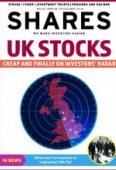Archived article
Please note that tax, investment, pension and ISA rules can change and the information and any views contained in this article may now be inaccurate.
Why you would invest in a fund which aims not to lose cash

Why would you invest in a product which has the limited ambition of not losing you any money?
For the uninitiated that question might be prompted by the existence of capital preservation investment trusts and funds whose principal aim is, as their name suggests, to preserve your cash.
However, Warren Buffett once observed that the first rule of investing is not to lose money and the second rule is not to forget the first rule and these funds actually have a decent track record.
In this feature we take a closer look at three asset managers who specialise in vehicles designed to protect capital while also purporting to offer ‘smoother’ long term capital growth.
THE MAIN PLAYERS
While we have focused on funds to make the analysis more meaningful, investors also have the option to invest in the same strategies through investment trust vehicles in the case of Ruffer and Troy Asset Management. Latitude Investment Management doesn’t run investment trusts.
These are respectively Ruffer Investment Company (RICA) and Troy Income and Growth (TIGT).
As the UK equity market marches ever upwards and US and European indices make new all-time highs, it might be prudent for investors to start thinking protecting gains and focusing on the risks.
The current investment landscape presents an unusual cocktail of risks due to the ultra-accommodative monetary policies adopted by the central banks after the financial crisis and the rapid rise in government debts related to the pandemic.
Duncan MacInnes, director of Ruffer reckons traditionally safe assets such as government bonds are unlikely to serve investors as well in future as they have in the past.
MacInnes told Shares ‘governments and central banks are now more determined and more emboldened to stimulate the economy into growth, deficits be damned and to tolerate or look through higher levels of inflation’.
Founder and chief investment officer Sebastian Lyon of Troy Asset Management is of a similar view in believing that bonds may have lost some of their diversification benefits (rising in value when equity markets fall).
To underline his concerns Lyon highlighted the 20% correction in 30-year US treasuries in the first quarter of 2021, the first loss of that magnitude experienced in more than a generation.
Risks attached to bonds have been increasing over the last decade according to Lyon and he pointed out that today it would take seven years of annual interest payments to recoup the capital loss from a 1% rise in interest rates.
Notably, all the managers featured prefer to own index-linked (inflation protected) bonds, representing around a third of portfolio assets, rather than conventional fixed income.

HOW HAVE THEY PERFORMED
It’s one thing talking a good game, but whatever the investment strategy, what counts most for investors is performance. All three funds covered in depth in this article have performed well over the last three years. A noteworthy feature of the returns is that the return profile has been smoother than underlying equity markets.
MacInnes points out that Ruffer has only had one meaningfully negative return in 25 years and the maximum peak to trough loss is less than 10%, while it has made money in the last three major bear markets in 2000, 2008 and 2020.
NO BENCHMARK
One of the key differences to note about all-weather funds is that aren’t tied to a benchmark because essentially, they can invest in anything they find attractive, and ignore what their peers are doing.
For instance, the funds may opt to have zero exposure to equities or 100% exposure and every permutation in between. They can invest in alternative assets and derivatives.
It’s probably fair to say that all three investment shops profiled have concerns about inflation. So perhaps it’s not surprising that when reporting to their clients, inflation measures feature as one of the investment hurdles to overcome.
For example, the Latitude Horizon Fund (BDC7CZ8) aims to deliver total returns of 3%-to-4% above inflation over time.
The fund adopts the consumer price inflation including housing costs measure, known as CPIH as a measure of inflation.
The Troy Trojan Fund (BZ6CNS31) aims to beat the retail price index over the longer term, defined as between five and seven years. The RPI comprises a different basket of goods to the CPI and is also calculated differently.
The Ruffer Total Return Fund (B80L7V8) says its aim is to deliver consistent positive returns regardless of how financial markets perform and to not lose money in any 12-month period.

HOW THEY ALLOCATE ASSETS
There is a striking similarity in the proportion of assets allocated towards equities and inflation protected bonds.
The managers acknowledge that equities can provide a natural hedge against inflation, while also contribute towards capital growth.
Notably both Ruffer and Troy allocate specifically to physical gold and gold shares to give them direct inflation protection while Latitude adopts an indirect approach.
Latitude takes the view that buying great businesses with pricing power and commodity businesses benefiting from rising prices can provide good protection in an inflationary environment.
Companies floating manager Freddie Lait’s boat include consumer stocks Diageo (DGE) and and Dutch brewer Heineken as well as oil giant BP (BP.).
Consumer stocks were sold off during the pandemic, and Lait took advantage to add exposure at more compelling values.
This is another feature of Latitude’s approach, believing that owning shares at a discount to his estimate of intrinsic value can provide an added layer of protection in wobbly markets.
Dedicated infrastructure funds and private equity managed assets have become an increasingly popular way to get exposure to assets with inbuilt inflation protection.
Lait believes he can get good exposure by owning liquid shares in public markets. Stocks owned include French concessions and construction companies Vinci and Eiffage SA.
ALTERNATIVE INVESTMENTS
Ruffer makes investments in alternative assets and illiquid investments. McInnes said the firm manages market risk either by reducing gross exposure (selling down assets) or by reducing net risk (hedging via unconventional/convex assets).

Convex assets are those where a relatively small investment can provide a skewed payoff and make a big difference to the portfolio under certain conditions.
The decision is dictated by the attractiveness of equities or other investments and/or the cost of the hedging.
Ruffer isn’t afraid of investing in controversial assets to diversify and protect capital. In late 2020 it invested in bitcoin before selling out completely at a substantial profit in early April 2021.
Latitude Horizon doesn’t invest in derivatives or employ leverage and the approach is to keep the strategy transparent to outside investors and highly liquid.
Likewise, Troy doesn’t invest in derivatives or alternative assets and prefers investing in high quality businesses which have the potential to compound returns.
All weather funds tend to be pricier than plain vanilla funds because they offer differentiated strategies and in the case of Ruffer, provide exposure to alternative assets and complex hedging strategies.
The Ruffer fund has a relatively high annual management charge of 1.5% and ongoing charge of 1.52%. The investment trust option is cheaper at 1% of assets and an ongoing charge of 1.08%.
The Troy Trojan fund has an ongoing charge of 1.01% while the Latitude Horizon fund has an ongoing charge of 1%. Ongoing charges include the estimated trading costs on top of the management charge.
Important information:
These articles are provided by Shares magazine which is published by AJ Bell Media, a part of AJ Bell. Shares is not written by AJ Bell.
Shares is provided for your general information and use and is not a personal recommendation to invest. It is not intended to be relied upon by you in making or not making any investment decisions. The investments referred to in these articles will not be suitable for all investors. If in doubt please seek appropriate independent financial advice.
Investors acting on the information in these articles do so at their own risk and AJ Bell Media and its staff do not accept liability for losses suffered by investors as a result of their investment decisions.

 magazine
magazine








